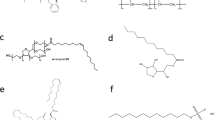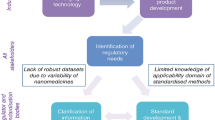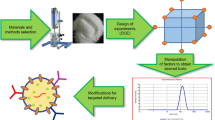Abstract
Nanotechnology and coamorphous are both advanced technologies that can effectively improve the solubility of drugs. This study has been the first attempt to combine these two approaches to construct the coamorphous nanoparticles to improve the dissolution and investigated the effect of physical properties of coamorphous solid on the nanosizing process. Two types of coamorphous solid, i.e., curcumin-artemisinin and quercetin-lysine, were selected as models. Coamorphous curcumin-artemisinin could highly contribute to the size reduction during milling compared to the crystalline form, which might attribute to the change of crystallinity. Nanosized coamorphous curcumin-artemisinin showed higher dissolution than nanocrystals and single coamorphous sample. However, quercetin-lysine coamorphous nanoparticles did not reflect significant dissolution improvement compared with the microsized sample. The difference of initial dissolutions for both could be the main reason. The directly mixing and drying method was confirmed to be an effective and simple approach to maintain the dissolution of nanosized coamorphous sample.









Similar content being viewed by others
Data Availability
All data generated or analyzed during this study are included in this published article.
References
Liu JW, Rades T, Grohganz H. The influence of moisture on the storage stability of co-amorphous systems. Int J Pharmaceut. 2021;605. ARTN 120802. https://doi.org/10.1016/j.ijpharm.2021.120802.
Ainurofiq A, Mauludin R, Mudhakir D, Soewandhi SN. A Novel Desloratadine-Benzoic Acid Co-Amorphous Solid: Preparation, Characterization, and Stability Evaluation. Pharmaceutics. 2018;10(3). ARTN 85. https://doi.org/10.3390/pharmaceutics10030085.
Dengale SJ, Grohganz H, Rades T, Lobmann K. Recent advances in co-amorphous drug formulations. Adv Drug Deliver Rev. 2016;100:116–25. https://doi.org/10.1016/j.addr.2015.12.009.
Mishra J, Lobmann K, Grohganz H, Rades T. Influence of preparation technique on co-amorphization of carvedilol with acidic amino acids. Int J Pharmaceut. 2018;552(1–2):407–13. https://doi.org/10.1016/j.ijpharm.2018.09.070.
Tian HY, Qin ZG, Wang GL, Yu XX, Chen JD, Lin ZQ, et al. Consideration of the dissolution media for drug nanocrystal evaluation. Powder Technol. 2021;392:179–90. https://doi.org/10.1016/j.powtec.2021.07.016.
Khan KU, Minhas MU, Badshah SF, Suhail M, Ahmad A, Ijaz S. Overview of nanoparticulate strategies for solubility enhancement of poorly soluble drugs. Life Sci. 2022;291. Artn 120301. https://doi.org/10.1016/J.Lfs.2022.120301.
Liu T, Yu XX, Yin HP. Study of Top-down and Bottom-up Approaches by Using Design of Experiment (DoE) to Produce Meloxicam Nanocrystal Capsules. Aaps Pharmscitech. 2020;21(3). ARTN 79. https://doi.org/10.1208/s12249-020-1621-7.
Liu T, Yu XX, Yin HP, Moschwitzer JP. Advanced modification of drug nanocrystals by using novel fabrication and downstream approaches for tailor-made drug delivery. Drug Deliv. 2019;26(1):1092–103. https://doi.org/10.1080/10717544.2019.1682721.
Tehrani AA, Omranpoor MM, Vatanara A, Seyedabadi M, Ramezani V. Formation of nanosuspensions in bottom-up approach: theories and optimization. Daru. 2019;27(1):451–73. https://doi.org/10.1007/s40199-018-00235-2.
Pinar SG, Canpinar H, Tan CM, Celebi N. A new nanosuspension prepared with wet milling method for oral delivery of highly variable drug Cyclosporine A: development, optimization and in vivo evaluation. Eur J Pharm Sci. 2022;171. Artn 106123. https://doi.org/10.1016/J.Ejps.2022.106123.
Hedaya M, Bandarkar F, Nada A. In vitro and in vivo Evaluation of Ibuprofen Nanosuspensions for Enhanced Oral Bioavailability. Med Prin Pract. 2021;30(4):361–8. https://doi.org/10.1159/000516299.
Ambrus R, Alshweiat A, Szabo-Revesz P, Bartos C, Csoka I. Smartcrystals for Efficient Dissolution of Poorly Water-Soluble Meloxicam. Pharmaceutics. 2022;14(2). ARTN 245. https://doi.org/10.3390/pharmaceutics14020245.
Kala SG, Chinni S. Development and Characterization of Venetoclax Nanocrystals for Oral Bioavailability Enhancement. Aaps Pharmscitech. 2021;22(3). Artn 92. https://doi.org/10.1208/S12249-021-01968-1.
Kumar S, Shen J, Burgess DJ. Nano-amorphous spray dried powder to improve oral bioavailability of itraconazole. J Control Release. 2014;192:95–102. https://doi.org/10.1016/j.jconrel.2014.06.059.
Gajera BY, Shah DA, Dave RH. Development of an amorphous nanosuspension by sonoprecipitation-formulation and process optimization using design of experiment methodology. Int J Pharmaceut. 2019;559:348–59. https://doi.org/10.1016/j.ijpharm.2019.01.054.
Morikawa C, Ueda K, Omori M, Higashi K, Moribe K. Formation mechanism of amorphous drug nanoparticles using the antisolvent precipitation method elucidated by varying the preparation temperature. Int J Pharmaceut. 2021;610. ARTN 121210. https://doi.org/10.1016/j.ijpharm.2021.121210.
Liu T, Yu XX, Yin HP. Impact of nanoparticle size and solid state on dissolution rate by investigating modified drug powders. Powder Technol. 2020;376:167–75. https://doi.org/10.1016/j.powtec.2020.07.091.
Allu S, Suresh K, Bolla G, Mannava MKC, Nangia A. Role of hydrogen bonding in cocrystals and coamorphous solids: indapamide as a case study. CrystEngComm. 2019;21(13):2043–8. https://doi.org/10.1039/c8ce01075g.
Dengale SJ, Hussen SS, Krishna BSM, Musmade PB, Shenoy GG, Bhat K. Fabrication, solid state characterization and bioavailability assessment of stable binary amorphous phases of Ritonavir with Quercetin. Eur J Pharm Biopharm. 2015;89:329–38. https://doi.org/10.1016/j.ejpb.2014.12.025.
Wang J, Chang RM, Zhao YN, Zhang JY, Zhang T, Fu Q, et al. Coamorphous Loratadine-Citric Acid System with Enhanced Physical Stability and Bioavailability. AAPS PharmSciTech. 2017;18(7):2541–50. https://doi.org/10.1208/s12249-017-0734-0.
Liu T, Muller RH, Moschwitzer JP. Consideration of the solid state for resveratrol nanocrystal production. Powder Technol. 2018;332:63–9. https://doi.org/10.1016/j.powtec.2018.03.028.
Mohammady M, Mohammadi Y, Yousefi G. Freeze-Drying of Pharmaceutical and Nutraceutical Nanoparticles: The Effects of Formulation and Technique Parameters on Nanoparticles Characteristics. J Pharm Sci-Us. 2020;109(11):3235–47. https://doi.org/10.1016/j.xphs.2020.07.015.
Nair A, Khunt D, Misra M. Application of quality by design for optimization of spray drying process used in drying of Risperidone nanosuspension. Powder Technol. 2019;342:156–65. https://doi.org/10.1016/j.powtec.2018.09.096.
Bennett RC, Brough C, Miller DA, O’Donnell KP, Keen JM, Hughey JR, et al. Preparation of amorphous solid dispersions by rotary evaporation and KinetiSol Dispersing: approaches to enhance solubility of a poorly water-soluble gum extract. Drug Dev Ind Pharm. 2015;41(3):382–97. https://doi.org/10.3109/03639045.2013.866142.
Hu XY, Lou H, Hageman MJ. Preparation of lapatinib ditosylate solid dispersions using solvent rotary evaporation and hot melt extrusion for solubility and dissolution enhancement. Int J Pharmaceut. 2018;552(1–2):154–63. https://doi.org/10.1016/j.ijpharm.2018.09.062.
Singh A, Van den Mooter G. Spray drying formulation of amorphous solid dispersions. Adv Drug Deliver Rev. 2016;100:27–50. https://doi.org/10.1016/j.addr.2015.12.010.
Jakubowska E, Lulek J. The application of freeze-drying as a production method of drug nanocrystals and solid dispersions-A review. J Drug Deliv Sci Tec. 2021;62. Artn 102357. https://doi.org/10.1016/J.Jddst.2021.102357.
Nandiyanto ABD, Okuyama K. Progress in developing spray-drying methods for the production of controlled morphology particles: From the nanometer to submicrometer size ranges. Adv Powder Technol. 2011;22(1):1–19. https://doi.org/10.1016/j.apt.2010.09.011.
Verma S, Kumar S, Gokhale R, Burgess DJ. Physical stability of nanosuspensions: Investigation of the role of stabilizers on Ostwald ripening. Int J Pharmaceut. 2011;406(1–2):145–52. https://doi.org/10.1016/j.ijpharm.2010.12.027.
Bi YP, Liu JJ, Wang JZ, Hao JF, Li F, Wang T, et al. Particle size control and the interactions between drug and stabilizers in an amorphous nanosuspension system. J Drug Deliv Sci Tec. 2015;29:167–72. https://doi.org/10.1016/j.jddst.2015.07.012.
Patel D, Zode SS, Bansal AK. Formulation aspects of intravenous nanosuspensions. Int J Pharmaceut. 2020;586. ARTN 119555. https://doi.org/10.1016/j.ijpharm.2020.119555.
Peltonen L, Strachan CJ. Degrees of order: A comparison of nanocrystal and amorphous solids for poorly soluble drugs. Int J Pharmaceut. 2020;586. ARTN 119492. https://doi.org/10.1016/j.ijpharm.2020.119492.
Wimalasiri VW, Dunuweera SP, Dunuweera AN, Rajapakse RMG. Noyes-Whitney Dissolution Model-Based pH-Sensitive Slow Release of Paclitaxel (Taxol) from Human Hair-Derived Keratin Microparticle Carriers. Biomed Res Int. 2021;2021. Artn 6657482. https://doi.org/10.1155/2021/6657482.
Shi Q, Moinuddin SM, Cai T. Advances in coamorphous drug delivery systems. Acta Pharm Sin B. 2019;9(1):19–35. https://doi.org/10.1016/j.apsb.2018.08.002.
Funding
Tao Liu received financial supports from Shandong Provincial Key R&D Program (project no. 2019GSF107006).
Author information
Authors and Affiliations
Contributions
Guoliang Wang: substantial contributions to the conception or design of the work, investigation and writing—original draft preparation. Yanchao Li: software, and drafting the work. Zhiguo Qin: investigation and interpretation of data for the work. Tao Liu: substantial contributions to the conception or design of the work, methodology, software, writing—original draft preparation, final approval of the version to be published and supervision.
Corresponding author
Ethics declarations
Conflict of Interest
The authors declare no competing interests.
Additional information
Publisher's Note
Springer Nature remains neutral with regard to jurisdictional claims in published maps and institutional affiliations.
Rights and permissions
Springer Nature or its licensor (e.g. a society or other partner) holds exclusive rights to this article under a publishing agreement with the author(s) or other rightsholder(s); author self-archiving of the accepted manuscript version of this article is solely governed by the terms of such publishing agreement and applicable law.
About this article
Cite this article
Wang, G., Li, Y., Qin, Z. et al. Nanosizing Coamorphous Drugs Using Top-Down Approach: The Effect of Particle Size Reduction on Dissolution Improvement. AAPS PharmSciTech 24, 14 (2023). https://doi.org/10.1208/s12249-022-02475-7
Received:
Accepted:
Published:
DOI: https://doi.org/10.1208/s12249-022-02475-7




